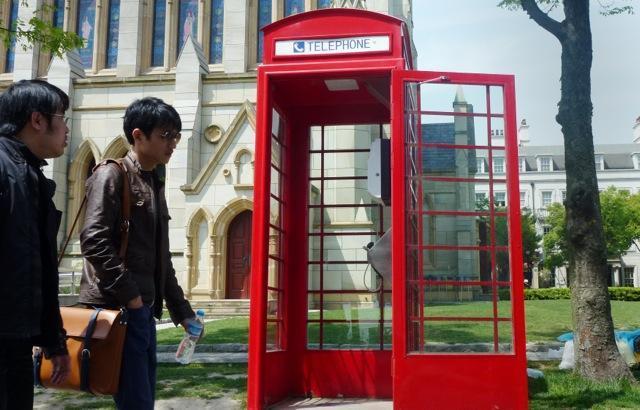China’s copycat town emblematic of Chinese passion for look-a-likes
Visitors stroll past a British phone booth on the church green in China’s Thames Town. (Photo by Ruth Morris.)
China may be the world’s most prolific copycat. It’s brought us pirated DVDs, fake iPhones and even entire fake Apple stores.
But what about knock-off architecture?
The city of Suzhou has a version of London’s Tower Bridge. Hangzhou has a faux Eiffel Tower. Then there are the full-scale copycat villages, like Thames Town, about 20 miles outside of Shanghai.
As you enter Thames Town, the honking and chaos of Chinese city life fall away. There are no more street vendors selling steamed pork buns, no more men hauling recyclables on three-wheeled bicycles. The road starts to wind around, and then, in the distance, you see what looks like a clock tower from a Cotswold village.
“It has this almost dreamlike quality of something European,” said Tony Mackay, a British architect, and the master planner for the Thames Town housing scheme and the surrounding district of Songjiang.
When local officials hired Mackay in 2001, he found farms and ducks here. Today, there are cobbled streets, pubs and half-timbered Tudor houses. There’s even a statue of Winston Churchill, and a medieval meeting hall that advertises chicken wings and beer in Chinese characters.
But Mackay is not happy.
“It doesn’t look quite right,” he said. “It looks false.”
Mackay says the architects who actually drew up the designs for the buildings created a pastiche, throwing together different styles, and throwing out authenticity.
Take the church, for instance.
“Windows are in the wrong place,” Mackay said. “The proportions are wrong. The use of the different stones is all wrong. It would never be used like that in the genuine English church.”
The houses in Thames Town were largely bought as investment properties, so the area is relatively empty. To Mackay, the place looks like a film set. In fact, one western blogger said it reminded him of the movie, The Truman Show.
But Fan Yu Zhe couldn’t care less.
Fan and his bride Sun Qi Yao were in the town, looking deeply into each other’s eyes as a photo assistant showered them with flower petals. Thames Town is crawling with young couples who want to have their wedding photos taken here. Fan says they chose this place because they are dying to visit Europe.
“I love European soccer, so I’m very interested in things from Europe,” he said. “I really hope I can visit the real Thames River one day, sit along the banks, drink a cup of coffee and enjoy the British sunshine.”
Nearby, a woman named Zhang Li snacks on tangerines and plays cards with her mother and aunt. Zhang says she’s come here on her day off because Chinese towns are so crowded and commercial, but here it’s green and pleasant. And she can’t afford to travel to England.
“Usually, if you want to see foreign buildings, you have to go abroad,” Zhang said. “But if we import them to China, people can save money while experiencing foreign-style architecture.”
There’s plenty of that in China.
“In Hangzhou I visited a replica of Venice, and there was a replica of Paris not that far away. In Beijing there is everything from Vienna Gardens, to the Palais de Fortune,” said Bianca Bosker, author of the book, “Original Copies: Architectural Mimicry in Contemporary China.”
Of course, it’s not just Chinese. Americans also build themed replicas, such as the country pavilions in Epcot in Florida.
But according to Bosker, while many westerners think of knock-off architecture as kitschy and bizarre, many in China find it truly lovely. She says that’s partly because China has a different attitude toward copying. In the West, copying signals a lack of imagination. But in China, she says, “mimicry is actually a form of mastery, in a symbolic sense.”
She notes that China’s first emperor celebrated the conquest of rival kingdoms by building replicas of their palaces within his own capital city. Now fast forward to China’s economic opening.
“By bringing in these copies of Paris or Venice or Amsterdam, China is, in a very symbolic way, showing off its ability to rearrange the cosmos, to sort of own the greatest hits of the West,” she said.
But perhaps not for much longer, according Mackay. China’s imitation towns are a fad, he says, a byproduct of China’s desire to connect with the world, but he sees a new trend emerging.
“The younger generations here they don’t want old-fashioned style, they want modernism. They want something new, which connects to their gear, their iPads, and their modern lifestyle,” he said.
One example is the sleek, ultra-modern Wangjing SOHO project in Beijing. When it’s finished, it will resemble three fish-like forms emerging from a stream. There’s just one problem: A suspiciously similar structure is being built in the city of Chongqing.
According to one industry publication, the alleged copy may be finished before the original.
